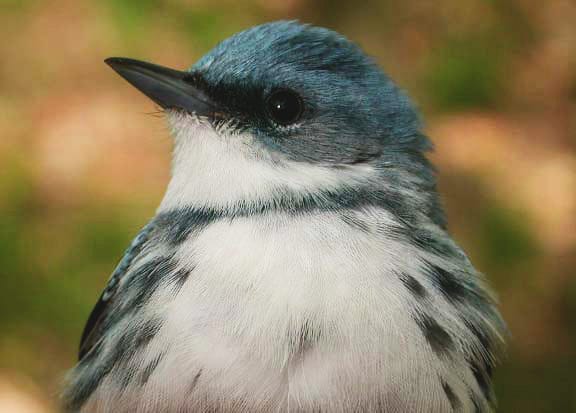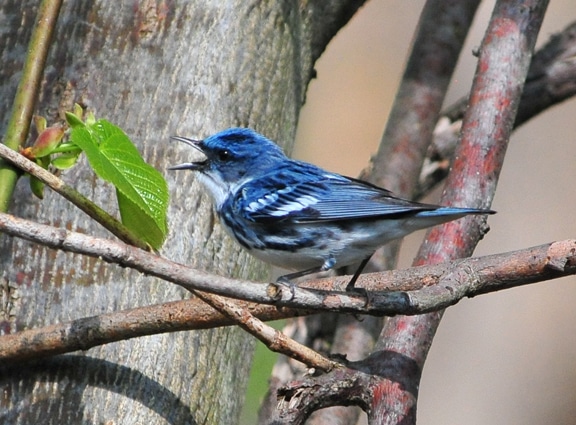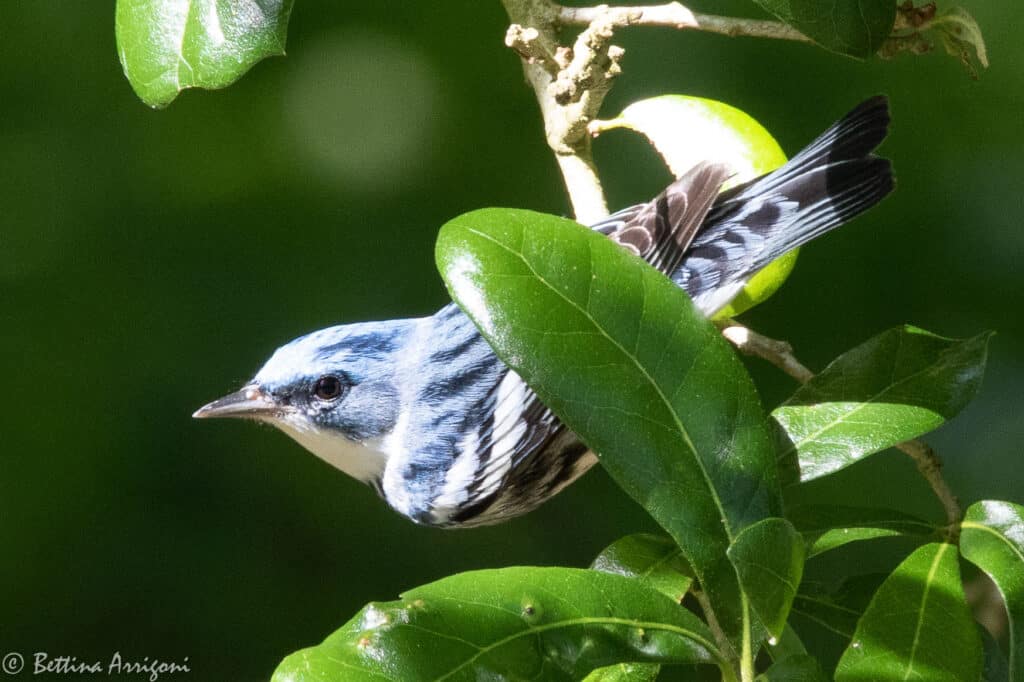
If you visit the FAB region, there is a good chance that you have spotted the Cerulean Warbler. This is a little song bird that makes this area their summer destination.
Cerulean warblers are a small, migratory songbird. They rely on the FAB region to provide their breeding grounds in the summer. This bird winters in South America in the northern ranges of the forests that edge the Andes Mountains.
These pretty little birds have one of the longest migration routes of any North American songbird! They cover a distance of up to 8,000 km each way between their breeding and wintering grounds. Imagine flying 16,000km each year!
It takes the warblers about 2 months for them to fly from their winter grounds to their breeding grounds here in Canada, but about 4 months when they head south again in the fall.
When the weather conditions are right to begin their trip, they often fly at night, so they can navigate with the sky. During the days, they rest and refuel with foods like caterpillars, beetles, and flies. They also eat some spiders and small fruits.
Considering all the flying they do each year, which is far more than many songbird species, it is not surprising that they consider Cerulean Warblers as one of the most acrobatic of the songbirds! Sometimes, people can spot them hanging upside down from tree branches or even flying upside down for short bursts when catching insects. Swallow type birds typically exhibit these flying behaviors, but it is not common in any other type of warbler species. It makes the Cerulean Warbler very unique!

During their migration and in the winter months, Cerulean Warblers can form mixed-species foraging flocks with other small songbirds in the area. This helps provide them added protection against predators and it helps them find food more efficiently.
These birds love mature deciduous forests with tall trees, especially those near water sources like rivers or streams. The FAB region is rich in exactly the habitat they are looking for. Frontenac Provincial Park, with its extensive forests and a variety of habitats is probably one of your best places to spot a Cerulean Warbler.
Since this bird is almost always in the tree tops, your best chance of identifying it is from below. Keep an eye out for the thin dark band that crosses the upper part of the predominantly white breast of the male.

Keep in mind that Cerulean Warblers are a threatened species in Ontario, so it’s important to follow proper birdwatching etiquette and especially to avoid disturbing them during their breeding season.
Cerulean Warblers breed only once a year, between May and August. People can hear the males making high-pitched buzzy songs to attract mates. The pairs will choose a nesting place together.
The females will build a cup-shaped nest high in the fork of a tree branch in the canopy of a mature deciduous forest. They will weave together fibers from bark, stems from grasses, and hair that they bind together with spiderwebs. At the beginning of nest construction, males occasionally help to collect spiderwebs, but the females do the majority of the work. The males defend their nesting territory against other Cerulean Warblers and may chase away other bird species that come close as well.
There are usually three or four nestlings hatched out each year. It takes about 11 days for the baby song birds to hatch, and another 10 days before they are ready to fledge from the nest. The Cerulean Warbler feeds mainly on insects during the breeding season, and young birds are fed primarily butterfly larvae. Outside the breeding season, they feed on nectar.
The female Cerulean Warbler has a rather unique way of leaving her nest after sitting on it. Some have called it “bungee-jumping” because she drops from the side of the nest, keeping her wings folded in, and doesn’t open them to fly until she is well below the nest. This probably prevents climbing predators from detecting where her nest may be located.
The life expectancy is about 4 – 6 years in the wild. Be prepared to stretch your neck if you want to spot these little songbirds! They spend much of their time, high in tree canopies 50 feet in the air.

Like all birds, Cerulean Warblers undergo an annual molt. Moulting is a process that replaces their feathers gradually over the course of a few weeks. Replacing damaged or worn feathers is very important for birds as it maintains their ability to fly and stay warm. For Cerulean Warblers, their molt usually takes place after the breeding season in late summer or early fall, before they make their long journey back to their wintering grounds. If you are bird watching during this time, keep in mind they may look slightly different in appearance as they replace their feathers.
The Cerulean Warbler’s predators include snakes, small mammals, and birds of prey such as hawks and owls, but it’s other dangers that are causing this bird so much harm. Cerulean Warblers are one of the most threatened migratory songbirds, with populations declining by more than 70% over the past forty years. This decline is primarily due to habitat loss and fragmentation, as well as threats from climate change, pesticide use, and other factors.
Conservation efforts to protect and restore their habitat are crucial to their survival. Supporting organizations like The Frontenac Arch Biosphere Network that work to protect forests and the species that inhabit them is an excellent way to help the Cerulean Warbler.
In your own backyard, reducing pesticide use can help, and avoid purchasing products that contribute to deforestation here in the region as well as in their winter grounds can also help support the conservation of this species.
Quick stats:
- Status: Species at Risk, Threatened
- Description: This small songbird is about 10 to 12 cm long. The adult males are deep cerulean blue on top, with white underneath and a distinctive blue-black band across the throat. The adult female is a beautiful blue-green on top, with whitish feathering underneath that can almost be yellowish, and yellow-white eyebrows. Both males and females have two prominent white wing bars and white tail spots.
- Habitat: Their habitat is mature, deciduous forests with big, tall trees, preferably with an open understory.
- Location: Cerulean Warblers can be found in isolated pockets all over southern Ontario, with the largest breeding area covering the FAB region.
Another important species in the FAB region is the White Tailed Deer. While these deer are not a Species At Risk, they do face threats and are a very important part of our ecosystem. Read more here White Tailed Deer





